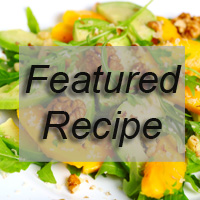Sicilian-Style Pasta
Serves 3
(Vegan; no gluten, dairy or legumes)
Sicily is at the bottom of the Italian boot. Due to its hot, dry climate and relative poverty its dishes use little meat and focus on an abundance of sun-ripened tomatoes. Savoury dishes are flavoured with dried fruit, nuts and sometimes a touch of chilli pepper. Meals are bulked up with lots of pasta and seasonal vegetables. The sauces that may accompany them are thickened with some of the starchy water left from cooking pasta.
Unlike gloppy overseas interpretations, most Italian sauces are subtle anointments. In this dish the light coating is a carrier for the salty punch of olives, the crunch of nuts, the sweetness of currants, and the peppery kick of chilli. Each ingredient can star but within an ensemble cast. The mixture of grain (pasta) and nuts in this is a good vegetarian protein combination. It can benefit further from added Protein (see article: TIPS), bulk and antioxidants by serving it with one of the Accompaniments below.
People with poor blood sugar regulation (see HEALTH STORE for my report: You Are Just A Few Steps Away From Peak Vitality), suboptimal Thyroid or Adrenal function (see TIPS for related articles), or those who have the ENTHUSIAST or ANALYSER metabolic body types (see HEALTH STORE for The Shape Diet and its questionnaire) all need to think strategically when planning meals based largely in carbohydrates such as pasta. To achieve steady levels of blood sugar for alert yet relaxed mental and physical function, it is essential for such people to include sufficient soluble and insoluble fibre, protein, crunchy foods such as salad (too much uniform texture, overcooking or highly refined foods can lead to spiking levels of blood sugar), a little good quality fat, culinary acids (such as the vinegar or lemon in a salad dressing) and other key factors.
Meal planning is about achieving appropriate relationships that uniquely suit you. It is not well served by declaring any wholefood or category of food as innately good or bad and practicing excessive avoidance or indulgence. Beware of nutrition claims that are characterised by faddism: carbs get deemed evil one season and fats or protein the next.
125 g cornmeal, rice, millet or buckwheat small pasta shapes*
***
2 Tbsp extra virgin olive oil*
heaped ¼ cup (5 Tbsp) chopped pistachios
1 large onion, sliced
12 green beans or asparagus, or 2 medium courgettes, sliced
1 medium carrot, halved lengthwise and thinly sliced
3 large cloves garlic, chopped
¼ tsp chilli flakes
***
250 ml (1 cup) reserved pasta water
¼ cup currants
3 Tbsp tomato paste
3 Tbsp chopped black olives
1 tsp sea salt with kelp*
Cook pasta according to packet instructions (8-10 minutes for Orgran* varieties) until al dente – resistant to the bite – and not mushy. Reserve 1 cup of cooking water. Drain the pasta, set aside and keep warm.
In olive oil over low heat gently sauté the nuts, onion, choice of seasonal green vegetable, carrot, garlic and chilli. Cook about 5 minutes until lightly softened. Stir in 150 ml of the reserved water, currants, tomato paste, olives and salt. Cover and simmer for 5 minutes until the vegetables are just cooked and the sauce is thick. At any point add more reserved water as needed to thin the sauce.
Add the pasta and cook for 2 minutes to warm and coat with sauce. Taste for salt and serve.
Shopping and Preparation Tips*
• Olive Oil: extra virgin olive oil is achieved by using cold mechanical pressure rather than the high heat and chemical solvents typical to most supermarket oils. These practices damage oils and the people who eat them. For information on which fats to choose for which purpose and why, see my article on the TIPS page: The Fats of Life.
• Pasta/Noodles: boil Asian rice noodles in ample water about 5 minutes until tender (or follow packet instructions as per minimum time); drain, rinse to prevent sticking; use. Orgran makes a wide variety of gluten-free pasta available in most supermarkets; usually rice-based or with buckwheat, corn, tapioca or mung bean flour (TIPS: Gluten). Lower in protein than ordinary pasta these are high-GI, so accompany with other blood sugar moderators (eg protein, fat, fibre, culinary acids, crunchy texture).
• Sea salt: is sea water dehydrated by sun. When mixed with seaweed (containing iodine and other minerals low in our soil) it is ideal in terms of flavour (interesting but not too strong) and mineral balance. Try Pacific Harvest or Malcolm Harker brands; both in health and gourmet stores. Ordinary salt is taken from mines or sea and so highly refined over extreme heat that it contains nothing but sodium chloride. All other minerals are stripped away, such as Potassium and Magnesium (TIPS) which help regulate fluid balance and blood pressure. Bleach as a whitener and chemicals to prevent clumping may be added to table salt.
Accompaniments
• Salad (such as spinach, fig, mushroom and red onion) with beans such as chickpeas, lentils or cannellini beans (cooked, or tinned and drained);
• Salad with grated firm tofu, or cubed tofu;
• Salad with slices of hard boiled egg or omelette;
• Salad with cubed organic cheese (soy, cow, sheep or goat);
• Salad with cooked or tinned fish.



